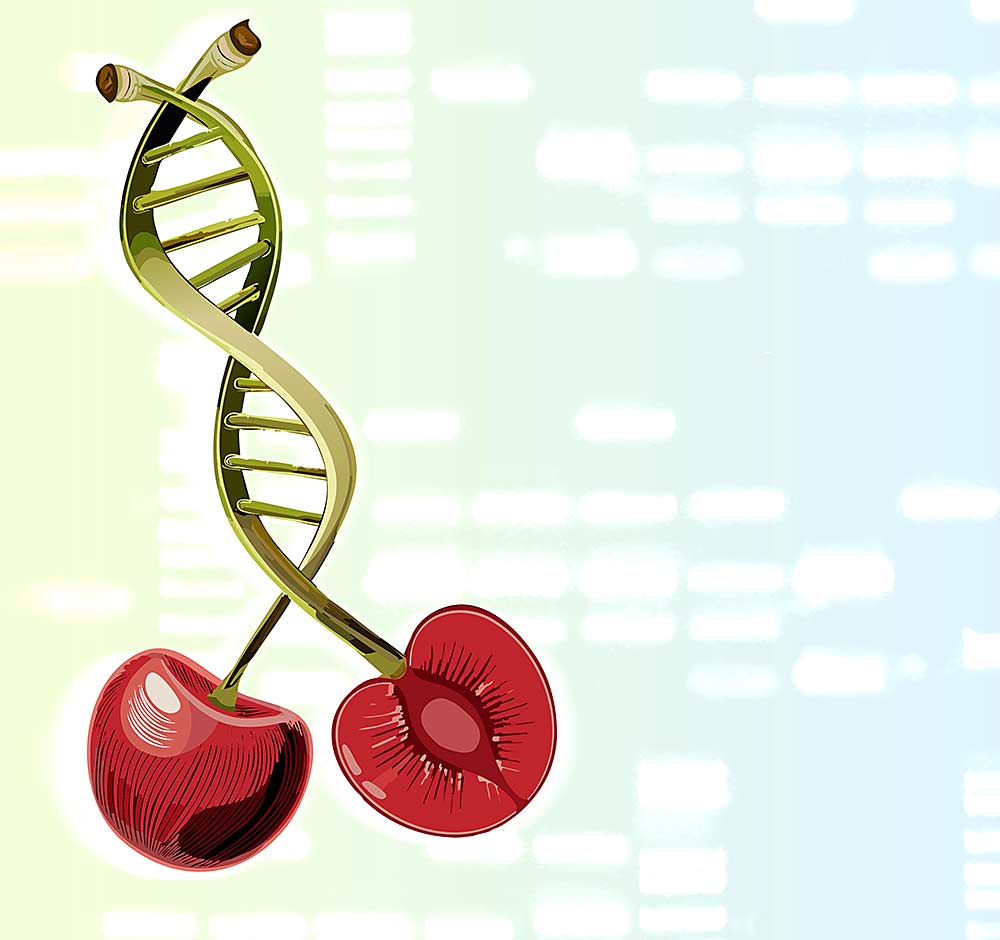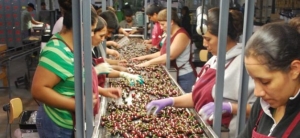—story by Ross Courtney
—photo illustration by TJ Mullinax

What does it take to identify a cherry?
According to a long-running court case between the Canadian government and a few Washington fruit businesses, it requires several forms of DNA screening, years of field experiments and a bench trial ruling by a federal judge.
Experts uninvolved with the case say that with modern genetic screening, it need not be so difficult.
“This should have been caught earlier,” said Dianne Velasco, plant identification lab supervisor for Foundation Plant Services, a clean plant center at the University of California, Davis.
With the emergence of many new proprietary varieties, Velasco and other genetic experts say screening should be more routine for growers and nurseries in the fruit industry, but the process for plant patents and protections has not required the use of modern technology.
Case in point: In 2020, Agriculture and Agri-Food Canada accused two producers and a nursery of propagating, growing and selling its late-maturing cherry cultivar Staccato under a different name, Glory. In August, after four years of hearings and testimony that included up to eight different genetic tests and phenotypical comparisons of fruit size, bloom timing and stem retention, a U.S. District Court judge in Eastern Washington ruled the two cherries were indeed the same. The lawsuit continues as the parties work through other disagreements.
Cameron Peace, a professor of tree fruit genetics at Washington State University, thinks that level of testing, designed to win a court battle, is overkill.
In most cases, one genotypic assay — looking for small variations within genetic code that could manifest into physical differences — should do the trick, he said. He suggests starting with something low-resolution and moving to a higher resolution if needed.
“If this happened in my research orchard, I would get onto the answer right away,” said Peace.
But not all genetic tests are created equal.
The Staccato-Glory dispute began with a grower who found an unusually late-maturing cherry in an orchard of a different variety. Had it truly been a unique chance sport, it would have given him and whoever sold the cherry an economic advantage in the late-market window.
According to court documents, that grower did hire a geneticist in 2008 to compare his “new” variety, Glory, against the Staccato and Sweetheart. However, that geneticist ended up with inconsistent results and later admitted to the court that the tests were less contemporary and robust than those conducted on behalf of the Canadian breeder.
In turn, the Canadian breeder hired its own geneticists to run more modern tests, a statistician to compare results from both sides and a horticulturist to perform five trials comparing phenotypes — physical, visible differences in the plants. They opined the two cherries were the same, and the judge agreed.
Testing technology
Laboratories throughout the U.S. offer genetic screening, Peace said, but not always on a scale a single grower with a single questioned variety could afford. Meanwhile, geneticists who understand the crop are sometimes in short supply. And for some crops, including cherries, the industry lacks centralized and accessible DNA reference information. There is no equivalent to the federal fingerprint database for agricultural plants.
Because of his history with RosBREED, a national team of scientists trying to improve the genetics of Rosaceae fruit, Peace performs SNP assays — a process that looks for single nucleotide polymorphisms: small genetic variations that can distinguish individuals of the same species or cultivar. Apple screenings are done at cost ($50) via MyFruitTree, a nonprofit research lab at WSU that offers DNA fingerprinting of apple trees. He sends samples of leaf tissue to wet labs in Wisconsin or Florida for screening.
In return, he receives raw data that he can read and compare to known references from more than 5,000 previously established apple DNA profiles.
However, most labs require minimum batch sizes of up to 384 samples. The lab Peace uses requires 192 samples, and he fields enough inquiries to meet that threshold — for apples, anyway.
Cherries, due to less demand, don’t have the advantage of such a deep database. Peace stopped offering cherry screening a few years ago, when a critical supplier stopped making cherry SNP arrays, the physical equipment used to run the screens.
Foundation Plant Services in California offers small-scale screens for anywhere from $300 to $410 per sample, but it does not currently have the capacity to serve the entire U.S. fruit and nut industry, Velasco said.
Her lab runs DNA tests known as simple sequence repeat, or SSR, to identify almond, apple, apricot, cherry, olive, peach, pistachio, plum and walnut, but grape is its main business. The lab has an internal database of about 1,700 unique grape profiles, while the searchable Vitis International Variety Catalogue has profiles for 6,350 cultivated varieties.
SSR tests and SNP assays were submitted as evidence in the Staccato-Glory lawsuit.
For apples, Foundation Plant Services compares against an SSR dataset available from the U.S. Department of Agriculture. But for cherry, it has only 150 variety profiles available in its internal database.
Cherries also have a narrower genetic base and therefore more similarities between varieties, Velasco said. So, the service screens for 15 genetic markers instead of the eight used for grapes.
Comparing the entire genome — whole genome sequencing — would be prohibitively expensive for routine identification, though one was eventually conducted for the Staccato litigation.
Patents
Patents don’t require genetic evidence, so they don’t do much to clear the air in a DNA dispute.
For a while, both Staccato and Glory had their own U.S. plant patents. Earlier in the legal proceedings, the judge invalidated the Staccato patent because of a timing mishap when it was filed, leaving a valid patent only for Glory. Then, his later decision named Staccato as the original variety.
That’s not as crazy as it might sound, said Michelle Bos, a Zillah, Washington, attorney who specializes in plant patents.
“U.S. plant patents are examined on paper only,” said Bos, who helped file the patent application for the grower who thought he discovered Glory.
U.S. plant patents, first established in 1930, require detailed written descriptions, drawings and photographs. As more plants have been patented over the years, those descriptions — called disclosures — have become longer and more detailed, but the process has never required DNA evidence.
Per McCord, WSU’s cherry breeder, is aware of the limits of the patent system as the university prepares to potentially launch up to three unnamed new cherries currently in late-stage commercial trials.
“The whole patent system was not made with plants in mind,” McCord said.
For the R19 cherry, the closest to release, the university has not yet decided whether to apply for a plant patent from the U.S. Patent and Trademark Office or seek protection under the U.S. Department of Agriculture’s Plant Variety Protection Office. Or both.
To prepare either way, McCord and the university have begun painstakingly logging data about bark color, leaf shape, growth habits and other physical characteristics of the tree during different times of the year, as well as fruit characteristics.
Broadening the use of DNA screening in orchards and nurseries could make a lot of sense to head off disputes before they happen, McCord said, but it wouldn’t be foolproof.
The university has tested the three varieties using a technique that generates from 1,600 to 3,400 genetic markers. Even then, it’s feasible that such a test would not reveal any difference between a variety and a chance sport, he said.
One lesson, the experts say, is that chance mutations do occasionally happen in tree fruit, though they are rare. There are examples of growers unexpectedly hitting the jackpot when they notice a physical characteristic different enough to warrant a unique, marketable variety.
However, a simple nursery mishap is more common, they said. If a tree looks different, it’s probably a different tree, accidentally bundled with an order of others. That’s how the Staccato-Glory dispute allegedly started.
McCord liked the idea of DNA testing early, especially any time there is confusion or doubt.
“If the origin of what you have is a little murky, then I think extra caution is warranted,” McCord said. •









Leave A Comment